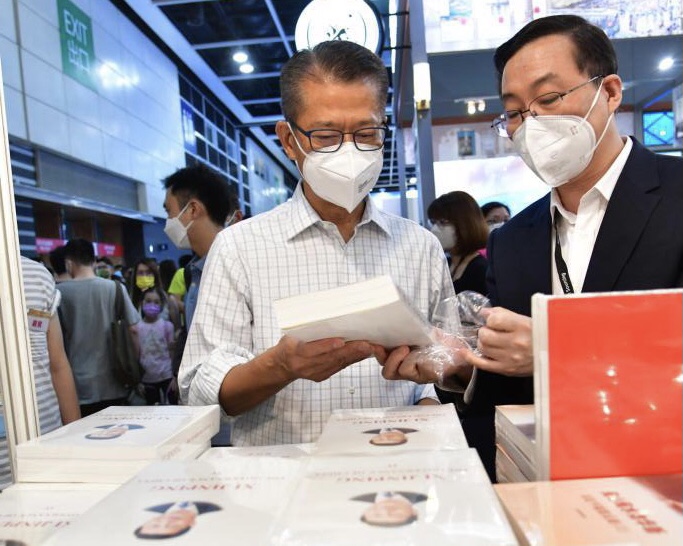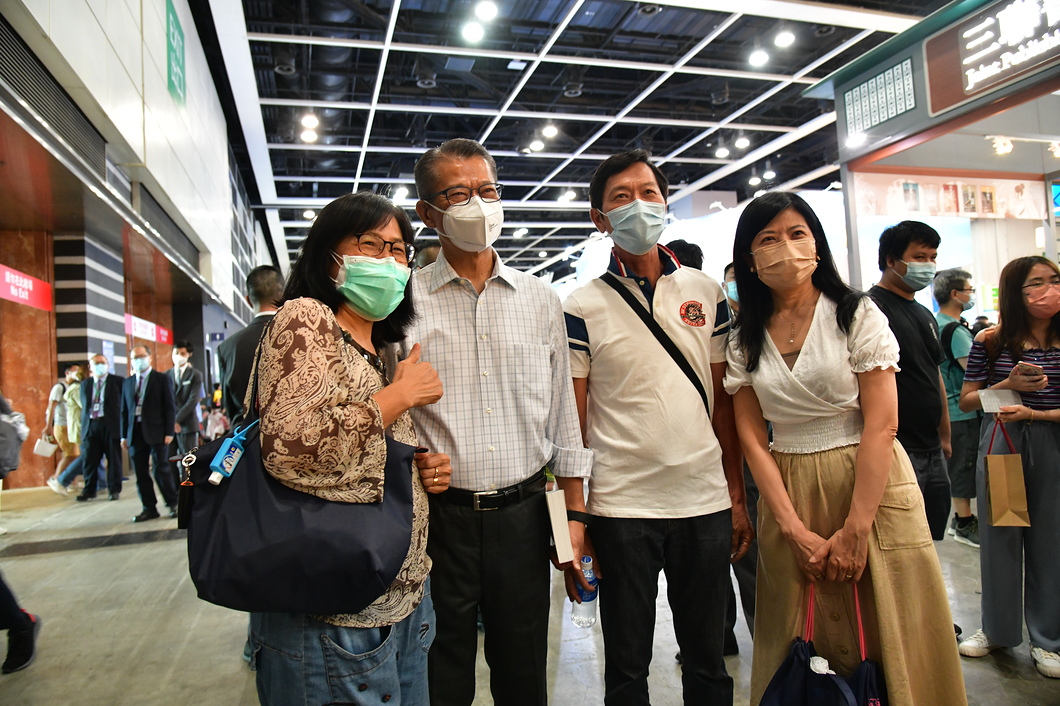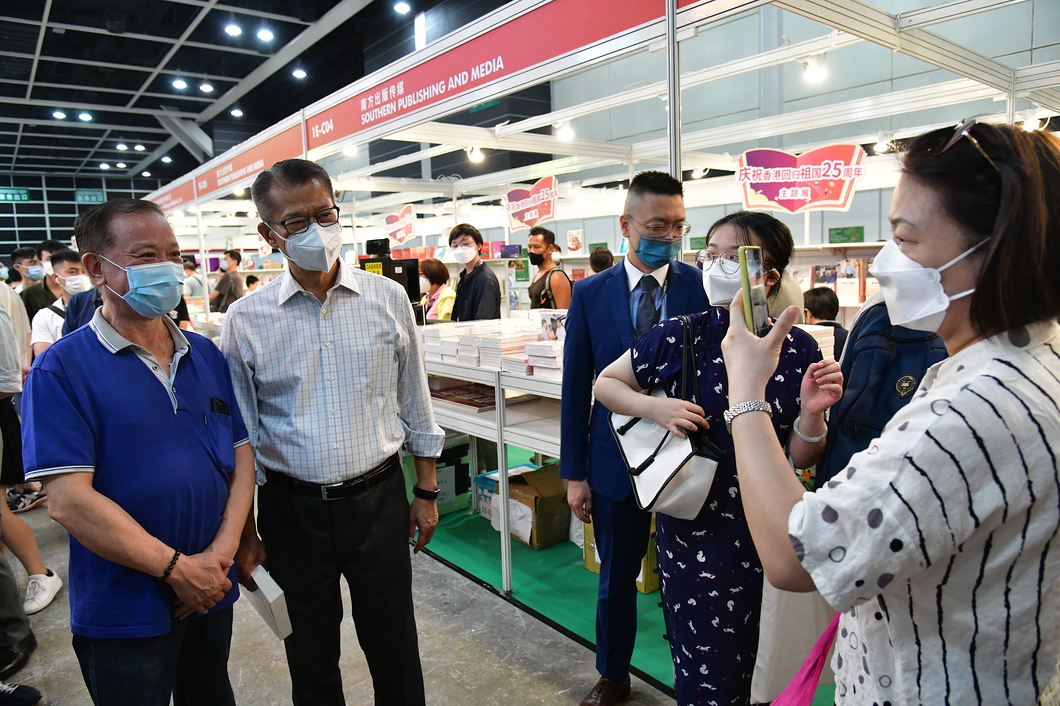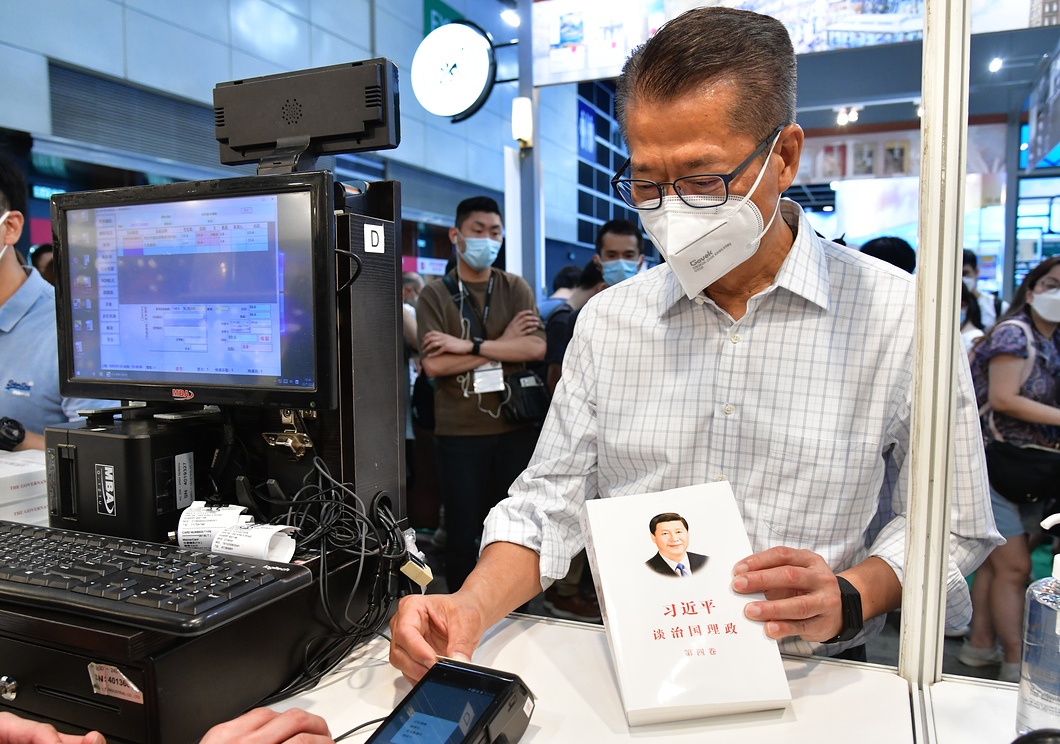Blog
Responding to economic and financial volatility with prudence
Although the local epidemic situation has seen a rebound over the past month or so, the majority of social and economic activities are still going on orderly as we adopt precise and targeted anti-epidemic measures. The Hong Kong Book Fair, which opened last week, has attracted many visitors. I joined two new book sharing sessions and bought some books in the Fair. Some exhibitors told me that there was a good flow of people at the Book Fair this year, and they were cautiously optimistic about their business.

|
| Yesterday I took a walk at the Hong Kong Book Fair to have a touch on the sentiment and had exchanges with visitors. I also bought some books and local handcrafts. |
When the overall economic performance is weak, and various trades and industries are generally under greater pressure, large-scale thematic exhibitions like the Book Fair could stimulate the consumption demand and bring about short-term employment opportunities. The upcoming disbursement of Phase II consumption vouchers will also likely play a role in stimulating the market and the economy.
The labour market in Hong Kong has improved somewhat lately. The unemployment rate in April to June was 4.7%, 0.7 percentage point lower than the high this year in February to April. Inflation remained largely moderate in overall terms, with underlying composite consumer price inflation at 1.8% in June. Nonetheless, as the global economy including the Mainland economy has been sluggish, we are not optimistic about the latest export figures for Hong Kong to be announced this week. For the economy as a whole, the economy contracted by 4% year-on-year in the first quarter due to the impact of the epidemic at the start of the year. Even though there might be some improvements to the advance estimates on gross domestic product for the second quarter, which is scheduled to be released early next month, the economic situation would hardly be ideal.

|
| Yesterday I took a walk at the Hong Kong Book Fair to have a touch on the sentiment and had exchanges with visitors. I also bought some books and local handcrafts. |

|
| Yesterday I took a walk at the Hong Kong Book Fair to have a touch on the sentiment and had exchanges with visitors. I also bought some books and local handcrafts. |

|
| Yesterday I took a walk at the Hong Kong Book Fair to have a touch on the sentiment and had exchanges with visitors. I also bought some books and local handcrafts. |
For the second half of the year, the pace and strength of economic recovery will still undergo considerable challenges. One of the main negative factors is that the US Federal Reserve and many major central banks are anticipated to raise interest rates substantially, raising concerns about the effect on the global economy and capital flows. Taking the US as an example, inflation has continued to intensify this year, and the consumer price index rose by 9.1% year-on-year in June, a 41-year high. In order to curb inflation, the Federal Reserve has raised interest rates three times this year by a cumulative 1.5 percentage points. Currently, the market widely expects that interest rates would further rise by a further 0.75 percentage point at this week’s meeting of the US Federal Reserve. If this materialises, the cumulative rise in interest rates for this year would reach 2.25 percentage points, which will lead to more fluctuations in capital flows and asset prices, and may also bring about volatility in the financial markets. Raising interest rates time and again would not be conducive to economic recovery. How the US could contain inflation on the one hand, and avoid getting caught in economic recession on the other, warrant close attention.
With the further interest rate hike in the US, capital flows and asset prices in the Hong Kong market would inevitably be affected. Most notably, under the Linked Exchange Rate System (LERS), there have been more carry trades in the market in view of higher interest rates in the US and relatively low interest rates in Hong Kong. Coupled with the subdued local demand for Hong Kong dollars (HKD) in recent months, the weak-side Convertibility Undertaking (CU) has been triggered multiple times since May. The Hong Kong Monetary Authority (HKMA) bought HKD and sold US dollars (USD) according to the established mechanism. With the triggering of weak-side CU, funds flow out from the Hong Kong dollar system, and hence we could hear the so-called “capital outflow” from the news. On the face of it, “capital outflow” may sound like lack of confidence in the market. But indeed it is a sign of confidence in LERS: in order to gain from interest rate arbitrages, carry trades are normally conducted only in markets where the currency is stable.
Since the global financial crisis in 2008, the US had implemented massive quantitative easing (QE), and it led to flooding of capital around the world. Since Hong Kong’s interest rates were consistently higher than the US interest rates at the time, and with the exchange rate guaranteed under LERS, a large amount of funds flew into Hong Kong, resulting in an exceptionally abundant level of liquidity in Hong Kong’s banking system. Some of the money was absorbed by HKMA through the issuance of Exchange Fund Bills and Notes. During the US’s last rate-hike cycle between 2015 to 2018, funds also flew out from the HKD system, and HKD interbank rates rose slightly upward following the US interest rates. However, funds flew back into the HKD system amid rate cuts and the relaunch of QE in the US in 2020. To date, a large amount of funds still remain in Hong Kong. At as the end of June 2022, the outstanding amount of Exchange Fund Bills and Notes was about $1.2 trillion, which was about 7.5 times of that in December 2008. Therefore, increases and decreases in the Aggregate Balance as a result of funds flowing in and out of the HKD system is part of the adjustment process under the design of LERS.
As the US has raised interest rates a number of times this year, capital holders selling HKD and buying USD to earn higher interest returns on their USD holdings have made a comeback. As of 22 July 2022, HKMA has bought over HK$170 billion and sold the equivalent amount of USD, and the Aggregate Balance declined to about HK$165 billion accordingly. According to the operation of LERS, where the weak-side CU is triggered, funds would flow out from the HKD system and the interest rate automatic adjustment mechanism would kick in. The HKD interbank rates will gradually rise, offsetting the incentives for carry trades, slowing down fund outflows from the HKD market, and ultimately stabilising HKD within the 7.75-7.85 band. The so-called “capital outflow” situation will ease.
Interest rate is the most powerful market adjustment force under the Currency Board system; and high transparency, stability and consistent enforcement of the system design are the strongest safeguards of HKD and LERS. Hong Kong’s public finances are sound, and the financial risk monitoring mechanism is robust. Our financial and banking systems have also over the years built up strong defence and resilience. We have a large foreign currency reserve (reaching US$440 billion), which is equivalent to about 1.7 times of the HKD monetary base. Our financial and banking systems have adequate liquidity; our banks are stable and have high asset quality. All these have reinforced our confidence about safeguarding LERS.
As for the property market, even though there has been a slight adjustment to local property prices in the past few months, it has remained largely stable. While more than half of private residential properties in Hong Kong are free of mortgage loans, as Hong Kong follows the US into a cycle of rising interest rates, the repayment burden of mortgage borrowers will increase. Members of the public should take a prudent strategy when buying property or making other investment decisions.
July 24, 2022